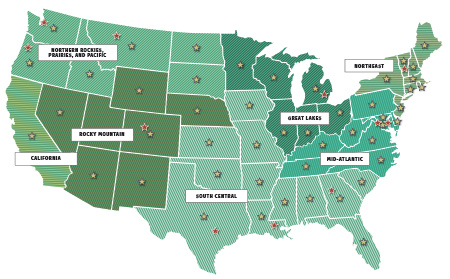Hunters, wildlife enthusiasts, and other conservationists are joining biologists and state wildlife agencies in Wyoming and Colorado to reverse population declines of one of the West’s signature species—the mule deer. The big-eared deer are found west of the Missouri River, especially in the Rocky Mountain region of North America. Some of the largest herds are found in western Colorado and Wyoming, which draw hunters and wildlife watchers from across the country.
However, along with other western states, Colorado and Wyoming have experienced decreases in mule deer populations. Suspected causes include drought, disease, predators, and human impacts to habitats such as roads and fences, the subdivision of land, and oil and gas drilling. A part of northwestern Colorado dubbed the “mule-deer factory” for its history of producing large numbers of deer once boasted a population of more than 100,000. In 2013 the herd was estimated at just 32,000 deer.
The National Wildlife Federation and Colorado Wildlife Federation produced the fact sheet “Legacy in the Crosshairs: Colorado’s ‘Mule-Deer Factory’ on the Decline,” which focuses on the renowned White River herd. Colorado Parks and Wildlife has held meetings across the state and is developing a plan to address the decreasing populations. In western Wyoming, the Wyoming Wildlife Federation and other sportsmen’s organizations have formed the Wyoming Mule Deer Coalition to work with state biologists and other to determine the causes of declining deer numbers and ways to rebuild the populations.
One of the resources used in understanding the needs of deer in Wyoming is the Wyoming Migration Initiative. Researchers have documented the longest migration of mule deer ever recorded—150 miles from southwest Wyoming’s Red Desert to the Hoback Basin in northwest Wyoming’s Bridger-Teton National Forest.
Wildlife biologist Hall Sawyer discovers the longest ungulate migration in the lower 48, nearly 5,000 mule deer migrate 150 miles in western Wyoming. The journey from the desert to the mountains that these deer undertake is truly remarkable. Photographer Joe Riis highlights and inspires the importance of conserving migration corridors around the world. Film produced by Joe Riis and the Cornell Lab of Ornithology. Visit migrationinitiative.org for more information.
A new storymap connects the dots between extreme weather and climate change and illustrates the harm these disasters inflict on communities and wildlife.
Learn MoreTake the Clean Earth Challenge and help make the planet a happier, healthier place.
Learn MoreA groundbreaking bipartisan bill aims to address the looming wildlife crisis before it's too late, while creating sorely needed jobs.
Read MoreMore than one-third of U.S. fish and wildlife species are at risk of extinction in the coming decades. We're on the ground in seven regions across the country, collaborating with 52 state and territory affiliates to reverse the crisis and ensure wildlife thrive.
